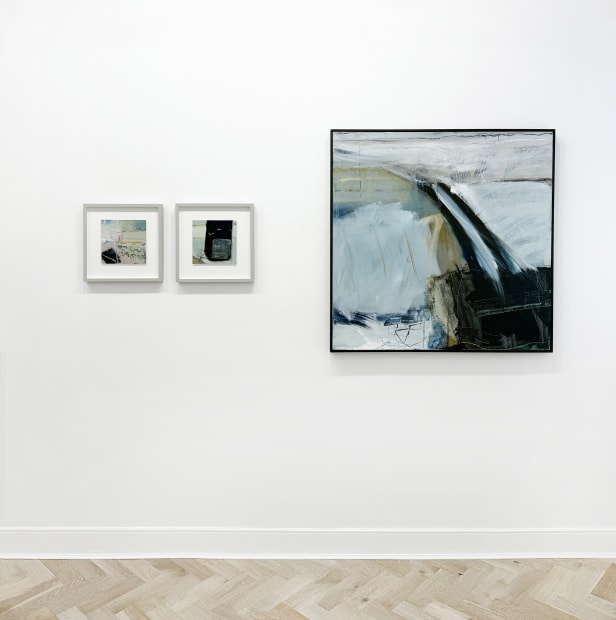-

-

-

-
Audience: When I look at your paintings, I see vast landscapes. Do you find inspiration more in the small details or the overall scene?
David: Most of my inspiration comes from the details—the weeds on the ground, lichen on rocks, the shape of a pebble, even a gull flying overhead. Those details excite me. I photograph and abstract them, but I also let the mood of the day sink in—whether stormy or sunny—and combine these things in my paintings. My goal is to communicate the visceral, emotional experience of being in the landscape, not just the view itself.
Audience: So, you’re translating experience rather than telling a story?
David: Exactly. I’m translating my intimate experience of the landscape. Walking through it, seeing countless small moments, feeling sensory impressions - the crash of waves, the shape of rocks, the movement of the eye across the scene. These multiple moments make up the experience, and I try to organise them in my paintings. It’s a combination of intimacy and the overall drama of the day. I want the viewer to feel both the drama and the personal experience of being in the landscape.
Audience: When you’re in the studio, are you reliving these experiences, or do they take on a new life as you paint?
David: Partly, I relive them, but I invent a lot as I go along, combining different days’ sketches and photographs. Sometimes I make collages in the studio, experimenting with colour and line. The process is fluid, and it creates a deep well of ideas, thoughts, and emotions to translate into painting.
-

-
Audience: How do you differentiate between seeing something for the first time and familiar landscapes?
David: You have to stay curious. New places challenge you, like my Newfoundland residency in 2022—it opened up new ways of painting. Cornwall is familiar, but I always look for new ways to see and communicate it. A different environment, like a Scottish island, could inspire an entirely new body of work.
Audience: What’s your ideal length for a residency?
David: Four to six weeks works well, like in Newfoundland. Enough time to immerse myself fully and develop new work.
-

-
Audience: How do you know when the balance isn’t right?
David: It can be difficult. Over time, experience helps. Sometimes a painting evolves gradually; sometimes you make a sudden change and a new harmony emerges. It’s a combination of intuition and analysis—using both heart and mind.
Audience: Does the scale of the painting affect this process?
David: Yes, it changes how I work. Large canvases require bolder gestures and slower changes. Smaller panels allow quicker experimentation. Some large works even start from small works on paper, scaled up and reinterpreted.
Host: How do you see a finished painting? As a whole, or as episodes of moments?
David: My paintings are built from episodes—moments I’ve sketched or photographed. They’re rarely about one specific place, but about capturing the essence of a day. That essence connects through the body of work, reflecting my love of sea and coastline, and the atmospheric drama of those landscapes.
-

-
Audience: Do your paintings live on in your mind after an exhibition?
David: Absolutely. Over 20 years, I’ve created around 500 paintings. They all remain in my memory, and I hope they inform future works. They form an ongoing dialogue in my practice.
Audience: What do you like most about being an artist, and what irritates you?
David: I love creating work and sharing it in galleries. Seeing people connect with my paintings is rewarding. Irritations exist—sometimes things don’t go to plan—but struggle is part of the process. Overcoming challenges reinforces passion and freedom in my work.
-

-
Audience: Do you use music in your practice?
David: Always. I never paint in silence. Music affects mood and emotion, helping me release them onto canvas. Different moods call for different music, palettes, or approaches. It’s about finding what resonates with the work at that moment.
-








